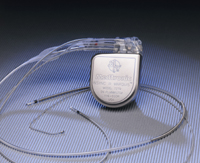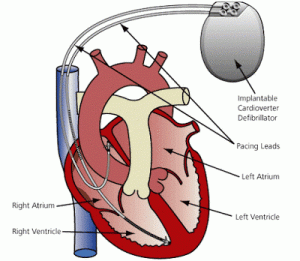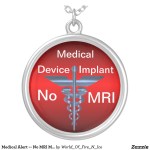What is a Biventricular ICD?
A biventricular ICD a small device used for cardiac resynchronization therapy for patients with heart failure. This constantly monitors your heart rate and rhythm and delivers small electrical impulses to both the left and right ventricles to help them contract at the same time.
This helps the heart to pump blood more efficiently with each beat. If any abnormal rhythm is detected, the ICD will deliver a shock to the heart back into a normal rhythm again.
This helps in treating dangerously fast rhythms that can lead to a sudden cardiac arrest.
Animation of how an ICD works
Who needs it?
- Moderate to severe heart failure with high risk of sudden cardiac death.
- Ejection fraction <35% (the amount of blood pumped out of the heart with each beat)
- Ventricular fibrillation
- Sustained ventricular tachycardia
- Interventricular conduction delay or bundle branch block
- Cardiomyopathy
How a normal heart beats:
In a normal heart, the muscles and chambers of the heart contract and relax in a synchronized regulated type of harmony together.
This timed synchronization or rhythm allows the ventricles to relax and fill with sufficient amount of blood then contract, pumping out a sufficient amount of blood throughout the body.
How does it work?
In a patient with heart failure, the chambers of the heart are not in sync with each other. This leads to an inadequate blood supply throughout the body and can lead to symptoms of heart failure.
Symptoms include shortness of breath, dry cough, swelling of the legs, irregular heart beats, or fatigue.
A biventricular ICD not only monitors the heart rate and rhythm but also senses dangerously fast heartbeats that can lead to cardiac arrest. If the device senses a life threatening heart beat, it will deliver a shock to the heart. This shock or defibrillation stops the abnormal rhythm and sets the heart into a regular rhythm again. This shock helps keep the contractions of the heart in sync and in a regular rhythm to provide adequate blood flow throughout the body.
This treatment resets the ventricular pumping system and is referred to as Cardiac Resynchronization Therapy (CRT).
What are the parts of a biventricular ICD?

Biventricular ICDsmonitor
- Battery: the ICD battery supplies the power to the ICD. This is a small, sealed, lithium battery that can lasts for years. Battery life usually lasts 5-10 years depending on how active your ICD is.
- Computerized generator: this is a miniature computer inside the ICD. The battery transmits electrical impulses that go through this generator to stimulate the heart to beat.
- Case: the battery and computer generator are sealed inside a metal casing.
- Leads: 3 flexible wires connect the generator to the walls of the heart.
What are the risks?
- Allergy: may produce an allergic reaction to the dye.
- Swelling, bruising, or bleeding at or around the implantation site.
- Formation of a clot (hematoma).
- Infection: can occur where there ICD was implanted.
- Damage to blood vessels or nerves around ICD site
- Collapse lung
- Device may move out of place from the heart.
- Device might not detect or appropriately treat your heart rhythm.
How is this diagnosed?
- Electrocardiogram (EKG) – a simple,non-invasive test that records the electrical activity of the heart and its beating pattern.
- Holter monitor– records the electrical events of the heart during your normal daily activities. It is important to accurately record your activities and symptoms so Dr. Jamnadas can compare them to the Holter monitor findings. If symptoms do not occur within 24 hours, an event recorder may be ordered for you for up to 30 days.
- Echocardiogram (ECHO) – shows images of the heart determining the size and shape of the heart, and shows whether the heart walls and pumping activity are normal or performing weakly.
- Stress test– helps access the blood flow to the heart at rest and during stress. Will detect if any areas receiving less blood flow.
What to expect:
Before the procedure:
Today ICD devices are amazingly small and average about 5 x 5cms, weighing only 1 to 3 ounces.
A biventricular ICD is usually implanted just beneath the skin of your chest, below the collarbone.
Biventricular ICDs are typically placed on the left side of the chest, but this may not be suitable for everyone.
The procedure will take place within a hospital and does not require general anesthesia.
You may or may not stay over night in the hospital. Pack an overnight bag just in case.
You will need to arrange for someone to pick you up and drop you off.
During the procedure:

An Illustration of how a biventricular ICD is placed in the heart
The entire procedure usually takes about one to two hours.
A sedative will be given to help you relax through an I.V. in your hand or arm that may make you sleepy.
Under sterile precautions, Dr. Jamnadas will inject a local anesthetic until you are fully numb in the area where the ICD will be inserted.
A needle will be inserted into a large vein to get access to the heart.
A dye will be given to view the heart under x-ray guidance.
To enter the heart, the ICD leads will be threaded through the vein and fixed to the wall of the right atrium and both right and left ventricles. The other end of the leads will be secured to the generator box.
The ICD settings are programmed to help your heart beat at a rate that is right for you.
Once the leads are fixed, Dr. Jamnadas will place a single incision just below the collar bone to insert the ICD underneath the skin of the chest.
After the ICD is placed within the chest, it will be tested to make sure it is working properly.
The incision will then be closed and a dressing will be applied.
After the procedure:

- Change your dressing as often as instructed and avoid getting the area wet for about a week.
- Take your temperature and check the incision everyday for signs of infection like redness, discharge, or a local rise in temperature.
- Learn how to take your own pulse and keep record of it.
- Avoid putting direct pressure on your ICD. For example, do not lie on your chest while sleeping at night.
- Let your primary health care provider or any other healthcare providers as well as dentist know about your ICD before receiving any treatment.
- Carry an ID card that contains information about your ICD. Your ICD may set off a metal detector while going through security. You may need to show this card to security personnel.
- Keep your cellular phone away from your ICD. Do not carry your phone in your shirt pocket, even when it is turned off.
- Avoid strong magnets including MRI scans and hand held security wands.noMRI
- Avoid strong electrical fields such as those made by radio transmitting towers, ham radios, and heavy duty electrical equipment.
- Avoid leaning over the open hood of a running car. A running engine creates am electrical field.
What can I use?
- Microwave ovens
- Computers
- Hair dryers
- Power tools
- Radios
- Televisions
- Stereos
- Electric blankets
- Vacuum cleaners
- Heating pads
- Cars
Call Dr. Jamnadas if you experience any symptoms of:
- Dizziness
- Palpitations
- Shortness of breath
- Fatigue
- Fainting spells
- Twitching chest muscles
- Chest pain or pain at ICD site
- Fever
- Hiccups that won’t stop
